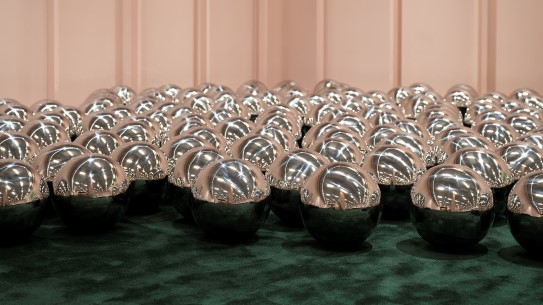Narcissus Garden
Yayoi Kusama
Transcription
Narrator:
Yayoi Kusama is a prominent Japanese contemporary artist known for her avant-garde artwork and captivating, immersive installations.
Her work often revolves around themes of infinity, repetition, obsession, and exploration of the human psyche.
Karen Reini-Svensson, art historian at the National Museum tells us more about Narcissus Garden…
Karen Reini-Svensson:
At the 33rd Venice Biennale in 1966, Kusama, self-invited and adorned in a gold kimono, presented the installation for the first time on a lawn outside the official programme. It comprised of 1500 mirrored spheres. She sold each sphere for two dollars under a sign stating, 'NARCISSUS GARDEN, KUSAMA' and 'YOUR NARCISSIUM FOR SALE'!
The police eventually became involved, and the work was forcibly shutdown!
The performative nature of this first iteration and its eventual closure are often read as a commentary on the contemporary art world's exclusionary nature and the commercialisation of art itself.
Narrator:
Since its inception, Kusama has exhibited Narcissus Garden in various settings, with the spheres now crafted from stainless steel instead of the original plastic.
Karen Reini-Svensson:
This particular iteration of the 'garden' features 1300 spheres, and the reflective surfaces produce a mesmerising and kaleidoscopic effect.
Stepping into the room, we are confronted with our own reflections, which are mirrored and distorted infinitely.
The title, Narcissus Garden, directly references the myth of 'Echo and Narcissus,' a story immortalised in the Ancient Roman poet Ovid's work 'Metamorphoses.'
According to the myth, Echo was a talkative nymph cursed to repeat only the last words spoken to her. She had fallen hopelessly in love with Narcissus, a handsome youth who became infatuated with his reflection in a pool of water, and ultimately wasted away staring at himself. Unable to express her feelings and rejected by Narcissus, who could love only himself, Echo pined and withered away until all that remained was the faint whisper of her voice.
The myth serves as a cautionary tale about the dangers of excessive vanity, love and self-absorption, and inspired Kusama's second source of reference: the concept of "Narcissism".
Narrator:
Kusama's interpretation of narcissism and the Narcissus myth delves into the themes of self-reflection, validation, and obsession.
The artwork's interactive quality challenges conventional notions of space and perception.
Karen Reini-Svensson:
Almost sixty years later, in the pervasive digital age of filtered realities and feedback loops, balancing self-expression and self-absorption, the work takes on new layers of meaning.
By immersing us into a sea of seemingly infinite mirrors, Kusama compels us to confront our own reflections and interact with our self-image and environment.
As we explore Narcissus Garden, we become both observers and subjects of the artwork.